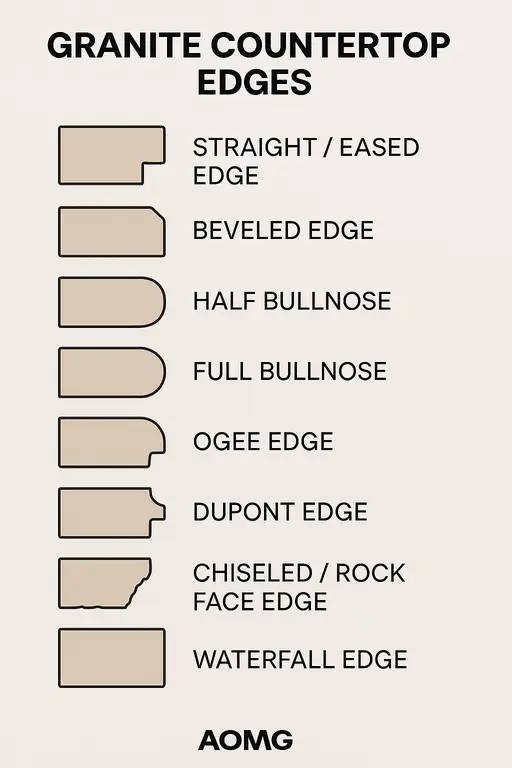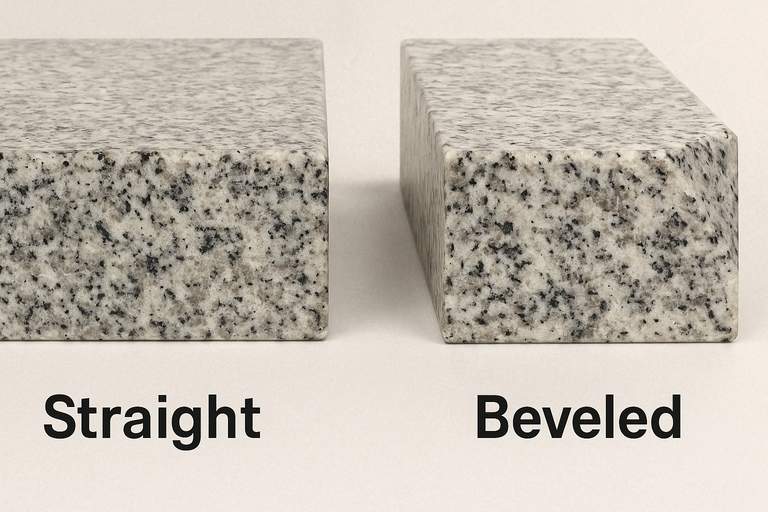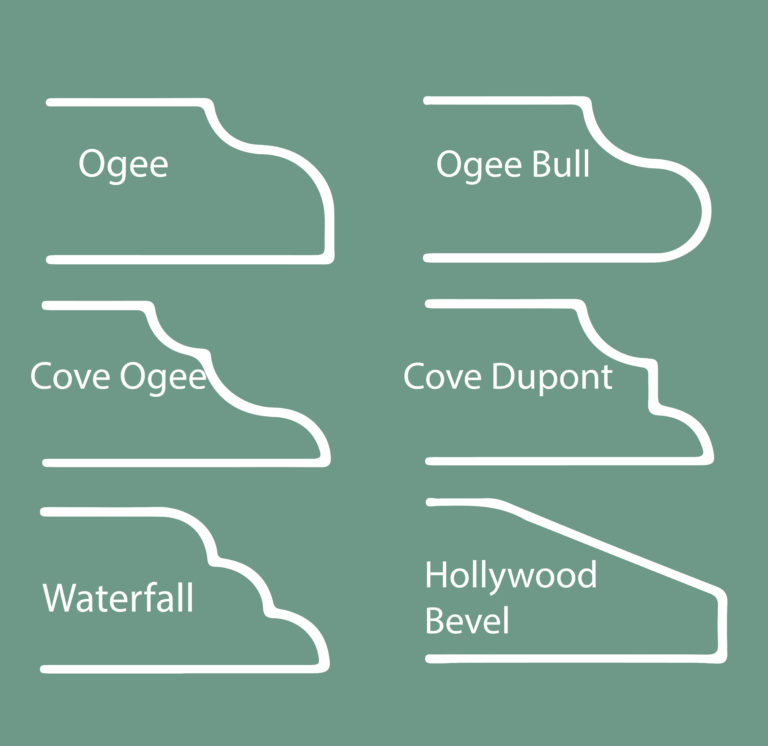A majority of people looking to install granite countertops for the first time will have an image like this in mind whenever they consider replacing their old laminate with new stone. However, one more design element has an equally significant impact on the overall appearance and ambiance of your kitchen or bathroom — the edge profile.
The different types of granite edges are more than just aesthetics. They influence durability, ease of cleaning, safety, you name it. So, regardless of whether your design point of view is a smooth, modern aesthetic, country farmhouse appeal, or luxury classical style, the perfect edge makes your countertops appear complete.
Throughout this article, we will cover the most common granite edge profiles and discuss the pros and cons of each variety so you can select the appropriate choice for your home.

Why Granite Edge Profiles Are So Important
Choosing a granite slab is a crucial decision, but the edge profile is what perfectly aligns the entire design. Here’s why it’s worth considering:
- Aesthetics: The edge is like a frame for a countertop, affecting whether the appearance is clean, decorative, or rustic.
- Functionality: Rounded edges are appropriate for children, while sharper edges reflect a contemporary style.
- Maintenance: Some edge profiles require less maintenance than others due to fewer grooves or crevices.
- Durability: Some edge profiles dispense impact smartly, which reduces chipping.
Most Common Granite Edge Types

- Straight / Eased Edge
A simple, squared edge with rounded corners to avert sharpness. It is a contemporary and minimalistic edge profile and mainly suited for modern décor styles.
- Pros:
- Clean lines that gel with any style.
- Quite affordable.
- Cons:
- Less ornate; may appear plain in conventional environments.
- Beveled Edge
This granite edge profile highlights a 45° angle cut along the top edge, which tends to differ in width. With its stylish and timeless profile, it pairs perfectly with both conventional and contemporary settings.
- Pros:
- Ingests subtle detail without over boarding the top.
- Simple and quick to clean.
- Cons:
- May not suit very casual or rustic designs.
- Half Bullnose
In the case of a half bullnose edge profile, the upper edge is rounded, with a flat bottom edge. This results in a subtle look due to lesser rounded structure.
- Pros:
- Resistant to spillage
- Easy to lean against.
- Cons:
- A bit overpriced than a straight edge.
- Full Bullnose
It is characterized by a completely rounded top and bottom edges. This profile is soft, smoothy, and perfect for family environments.
- Pros:
- No sharp edge —kid-friendly.
- Easy to clean.
- Cons:
- Gives a thinner look to the countertop.
- Easy dripping of liquids onto cabinets.
- Ogee Edge
Ogee edge profile highlights a decorative S-shaped curve, concave at the top and convex at the bottom. It is considered a premium edge profile.
- Pros:
- Gives quick elegance.
- Perfect for premium kitchens and baths.
- Cons:
- Very costly due to complex fabrication.
- A bit harder to clean.
- Dupont Edge
This granite edge is highlighted by a steep vertical drop trailed by a rounded curve. It looks dramatic and tailored.
- Pros:
- Visually appealing and unique.
- Frequently used for focal areas like kitchen islands.
- Cons:
- High-end pricing.
- May look a bit awkward with minimalist designs.
- Chiseled / Rock Face Edge
This granite edge profile lends a rough, natural break in the stone for a fresh, organic visual appeal. It is rustic and outdoor-friendly.
- Pros:
- Distinctive texture and natural appearance.
- Works perfectly in outdoor kitchens.
- Cons:
- Harder to clean.
- May hitch clothing if not smoothed perfectly.
- Waterfall Edge
This granite edge profile boasts a deep, incessant curve from the top end to the vertical drop.
- Pros:
- Lends artistic touch.
- Ideal for statement islands.
- Cons:
- Costly and time-consuming to fabricate.
Choosing The Right Granite Edge Profile
Below are some crucial factors to consider while exploring various granite edge profiles:
- Your Design
- Modern: Straight, eased, or mitered granite edges are ideal options.
- Traditional: Ogee, Dupont, or full bullnose edge profiles go well.
- Rustic: Chiseled or rock face edges complement authentic texture.
- Functionality & Safety
- The safest for households with kids is rounded edges (half or full bullnose)
- Opt for ground-based mechanisms around the edges so that liquids do not make their way into your cabinets. ·.
- Budget
- It is often the cheapest trim with straight, eased or simple bevel.
- More intricate designs, such as ogee and Dupont are more expensive to produce.
- Cleaning & Maintenance
- The smooth edges clean up easier than the grooves.
- Simple is also less maintenance when it comes to busy kitchens.

Pro Tip: Mix and Match
You do not have to select one edge for your entire kitchen. Most designers choose a fancier edge profile for the kitchen island and something simpler on the surrounding counters. This really gives you a place for the eye to rest while not killing your entire budget.
The Conclusion
When it comes to choosing granite countertops, people make an investment in beauty and function. These granite edge profiles will add the beautiful finishing touch to complete a design and increase the overall safety, all while blending into the lifestyle. There is always a granite edge option that perfectly complements your design, from sleek straight lines to sculptural curves.
With a nice balance of style, practicality, and budgeting, you might find an edge profile that works that not only looks stunning on day one but functions like new for years down the road.
